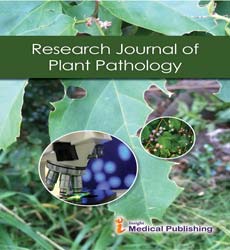Symptoms of Powdery Mildew in Erysiphales
Ryan Davison*
Department of Plant Microbiology, University of Potsdam, Germany
- *Corresponding Author:
- Ryan Davison
Department of Plant Microbiology,
University of Potsdam,
Germany,
E-mail: ryan.davison2395@cuvox.de
Received Date: July 02, 2021;Accepted Date: July 16, 2021;Published Date: July 23, 2021
Citation: Davison R (2021) Symptoms of Powdery Mildew in Erysiphales. J Plant Pathol Vol.4 No.3:3.
About the Study
Fine mould is a parasitic illness that influences a wide scope of plants. Fine mold illnesses are brought about by a wide range of types of organisms in the request Erysiphales. Fine build up is one of the simpler plant sicknesses to distinguish, as its manifestations are very particular. Tainted plants show white fine spots on the leaves and stems. The lower leaves are the most influenced, however the build-up can show up on any over the ground part of the plant. As the sickness advances, the spots get bigger and denser as huge quantities of agamic spores are framed, and the mold may spread here and there the length of the plant.
Fine mold fills well in conditions with high mugginess and moderate temperatures. Greenhouses give an optimal soggy, mild climate for the spread of the illness. This makes hurt agrarian and plant rehearses where fine mold may flourish in a nursery setting. In a rural or plant setting, the microorganism can be controlled utilizing compound strategies, bio natural techniques, and hereditary obstruction. Know about fine mold and its administration as the subsequent infection can essentially diminish significant harvest yields.
Reproduction
Fine mold growths can just repeat on their living cell have and recreate both physically and asexually. Sexual proliferation is by means of chasmothecia (some time ago cleistothecium), a kind of ascocarp where the hereditary material recombines. Fine mold growths should be adjusted to their hosts to have the option to contaminate them. Inside every ascocarp are a few asci. Under ideal conditions, ascospores develop and are delivered to start new infections. Conditions essential for spore development vary among species. Agamic propagation is the place where the mother organisms and posterity are hereditarily identical. Powder build-up growths posterity of wheat and grain species are more fruitful from a biogenetic generation contrasted with sexual multiplication counterparts.
Transmission of Vectors
Woolly aphids (Eriosomatinae) and other sucking creepy crawlies are regularly vectors of transmission for fine mold, and other irresistible sicknesses. Commonly woolly aphids in sub calm environments go before and are a pointer of different contaminations, including Powdery mold. Aphids infiltrate plant surfaces where they frequently live and give a large group of expected inoculants through physical, stomach related or faecal discharges. Aphids are frequently a marker of other potential plant issues.
Management
In a rural setting, the microbe can be controlled utilizing compound techniques, hereditary opposition, and cautious cultivating strategies.
Conventional Chemical Control
Standard fungicides are a successful method to oversee fine mold infection on plants. Shower projects of traditional fungicides are encouraged to start when fine mold manifestations and signs are first taken note. Traditional fungicides ought to be applied consistently for best outcomes against the infection. Control is conceivable with triadimefon and propiconazole. It is likewise conceivable with hexaconazole, myclobutanil, and penconazole.
Non-Conventional Chemical Control
There are some whimsical synthetic control strategies that offer elective methods of activity. The best non-traditional strategies for synthetic control against fine build-up are milk, regular sulphur (S8), potassium bicarbonate, metal salts, and oils. Fine mold on a maple leaf as seen under an examining electron magnifying instrument. Metal salt fungicides ought to be applied consistently up until reap of the host. Sulphur should be applied before the infection has arisen since it keeps organisms spores from sprouting. Copper sulphate is a compelling fungicide permitted in natural cultivating, yet can make hurt the host plant. Expansion of lime hampers this impact. Neem oil adequately oversees fine mold on numerous plants by meddling with the parasite's digestion and ending spore creation. Sulphur and Fish Oil + Sesame Oil is a blend compelling against fine build-up.
Genetic Resistance
The Pm3 allele is a compelling hereditary obstruction procedure that ensures have species against fine mold growth.
Open Access Journals
- Aquaculture & Veterinary Science
- Chemistry & Chemical Sciences
- Clinical Sciences
- Engineering
- General Science
- Genetics & Molecular Biology
- Health Care & Nursing
- Immunology & Microbiology
- Materials Science
- Mathematics & Physics
- Medical Sciences
- Neurology & Psychiatry
- Oncology & Cancer Science
- Pharmaceutical Sciences
